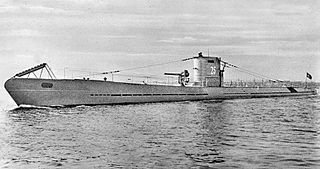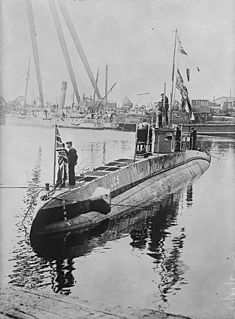This page is based on this
Wikipedia article Text is available under the
CC BY-SA 4.0 license; additional terms may apply.
Images, videos and audio are available under their respective licenses.

The Type II U-boat was designed by Nazi Germany as a coastal U-boat, modeled after the CV-707 submarine, which was designed by the Dutch dummy company NV Ingenieurskantoor voor Scheepsbouw den Haag (I.v.S) and built in 1933 by the Finnish Crichton-Vulcan shipyard in Turku, Finland. It was too small to undertake sustained operations far away from the home support facilities. Its primary role was found to be in the training schools, preparing new German naval officers for command. It appeared in four sub-types.

U-boat is an anglicised version of the German word U-Boot [ˈuːboːt] (listen), a shortening of Unterseeboot, literally "underseaboat." While the German term refers to any submarine, the English one refers specifically to military submarines operated by Germany, particularly in the First and Second World Wars. Although at times they were efficient fleet weapons against enemy naval warships, they were most effectively used in an economic warfare role and enforcing a naval blockade against enemy shipping. The primary targets of the U-boat campaigns in both wars were the merchant convoys bringing supplies from Canada and other parts of the British Empire, and from the United States to the United Kingdom and to the Soviet Union and the Allied territories in the Mediterranean. German submarines also destroyed Brazilian merchant ships during World War II, causing Brazil to declare war on the Axis powers in 1944.

The Type I U-boat was the first post–World War I attempt by Nazi Germany's Hocheseeflotte to produce an oceangoing submarine. Only two Type IAs were built, but the decision to halt production on further boats is believed to be because of political decisions and not because of major faults in the Type I design. Although the boats did not have any major design faults, they were known to be difficult to handle due to their poor stability and slow dive rate. The type was based on the design of the Finnish Vetehinen class and the Spanish Type E-1, designed by Ingenieurskantoor voor Scheepsbouw. The design later served as a basis for the development of other types of boats, primarily the VII and IX classes.
Friedrich Krupp Germaniawerft was a German shipbuilding company, located in the harbour at Kiel, and one of the largest and most important builders of U-boats for the Kaiserliche Marine in World War I and the Kriegsmarine in World War II. The original company was founded in 1867 but went bankrupt and was bought out by Friedrich Krupp. Krupp was very interested in building warships and in the time before the First World War built a number of battleships for the Kaiserliche Marine, including SMS Posen, SMS Prinzregent Luitpold, SMS Kronprinz, and SMS Sachsen. A total of 84 U-boats were built in the shipyard during the war. After the war it returned to the normal production of yachts and transports.
German submarine U-303 was a Type VIIC U-boat of Nazi Germany's Kriegsmarine during World War II. She saw service in the Atlantic Ocean and Mediterranean Sea, and sank one freighter of 5,000 tons in her three short and uneventful war patrols. Built in 1941 and 1942 at Lübeck, U-303 was a Type VIIC U-boat, capable of lengthy ocean patrols and of operating in distant environments.
U-10 may refer to one of the following German submarines:
U-30 may refer to one of the following German submarines:
U-20 may refer to one of the following German submarines:

The Mediterranean U-boat Campaign in the Mediterranean Sea was fought by Austria-Hungary and German Empire against the Allies during World War I. It was characterised by the ability of the Central Powers to raid with near impunity during the first years of the war, causing substantial shipping losses, until the introduction of the convoy system allowed the Allies to drastically cut their losses from 1917 on.
U-159 may refer to one of the following German submarines:
SM U-159 was a Type U-158 submarine of the Imperial German Navy, built during the First World War.
German submarine U-252 was a Type VIIC U-boat of Nazi Germany's Kriegsmarine during World War II. The submarine was laid down on 1 November 1940 at the Vegesacker Werft at Bremen as yard number 17, launched on 14 August 1941 and commissioned on 4 October under the command of Kapitänleutnant Gunter Schiebusch.
German submarine U-321 was a Type VIIC/41 U-boat of Nazi Germany's Kriegsmarine during World War II.
German submarine U-536 was a Type IXC U-boat of Nazi Germany's Kriegsmarine during World War II.

A coastal submarine or littoral submarine is a small, maneuverable submarine with shallow draft well suited to navigation of coastal channels and harbors. Although size is not precisely defined, coastal submarines are larger than midget submarines, but smaller than sea-going submarines designed for longer patrols on the open ocean. Space limitations aboard coastal submarines restrict fuel availability for distant travel, food availability for extended patrol duration, and number of weapons carried. Within those limitations, however, coastal submarines may be able to reach areas inaccessible to larger submarines, and be more difficult to detect.
German submarine U-775 was a Type VIIC U-boat built for Nazi Germany's Kriegsmarine for service during World War II.
She was laid down on 22 January 1943 by Kriegsmarinewerft Wilhelmshaven as yard number 158, launched on 11 February 1944 and commissioned on 23 March 1944 under Oberleutnant zur See Erich Taschenmacher.







